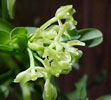|
|
|
|
|
| |
Flasks of
Epidendrum difforme 'Elizabeth' -spontaneous |
|
| |
|
|
| |
|
|
Click to Enlarge

Pod Parent Flowers |
|
|
|
| |
Comments: Parent plant: Medium-sized plant.
For additional origin/habitat information supplied courtesy of
Charles and Margaret Baker, see further below, near the bottom of this page.
|
Temperatures we attempt to use in the lab & greenhouse:
| For Species: |
|
Summer, Autumn: days average 80°F, nights 64°F; best fit is Intermediate 83-60°F
(Source:
Baker's Web OSC) |
| For Species: |
|
Spring: days average 83°F, nights 62°F; best fit is Intermediate 83-60°F
(Source:
Baker's Web OSC) |
| For Species: |
|
Winter: days average 77°F, nights 58°F; best fit is Cool-Intermediate 75-58°F
(Source:
Baker's Web OSC) |
|
About the name...
| Etymology of |
difforme |
|
From Latin "difformis" different.
(Source:
Mayr & Schmucker 1998) |
| Etymology of |
Epidendrum |
|
From Greek "epi" upon; "dendron" tree.
(Source:
Pridgeon 1992) |
| Pronunciation of |
difforme |
|
dif-FOR-mee
(Source:
Hawkes 1978) |
| Pronunciation of |
Epidendrum |
|
eh-pee-DEN-drum
(Source:
Pridgeon 1992) |
|
If you would like to direct someone to this web page, please copy and paste this URL into your email:
http://troymeyers.com/d?012911
| Flask Information |
| Availability: |
Seed not viable- failed. We were not able to make any flasks. |
| You should: |
Consider placing a "Notify Retries" Request, and if an identical pollination (the same parents) is done again, we'll let you know. |
|
You might also want to:
|
View the seed assay for this item.
View items of the same species.
View items of the same genus.
|
| Ordering Information |
| You are not currently logged in. |
|
You must be a registered user and be logged in to reserve a flask or place a notification request. Please log in:
|
|
|
|
|
|
| |
The origin/habitat information below is supplied courtesy of Charles and Margaret Baker
The following information is based on the name of the plant provided by the donor, and assumes that the name is correct. If the plant has been misidentified, then the following information may not be correct.
This text is copyrighted by the Bakers and may not be reproduced without permission.
ORIGIN/HABITAT: Found in the American Tropics from southern Florida
through the Caribbean, including the Lesser Antilles. Distribution extends
from Mexico, where plants have been found in the states of Chiapas,
Guerrero, Oaxaca, Quintana Roo, San Luis Potosí, Tabasco, and Veracruz,
through Central America and into northern South America, including
Venezuela, Colombia, Ecuador, and Peru. In Mexico, plants grow in
relatively dry areas, often in full sun. In Guatemala, numerous
collections have been made in Alta Verapaz, Chimaltenango, Chiquimula,
Guatemala, Huehuetenango, Izabal, Jutiapa, and Quezqltenango at elevations
from near sea level to 9850 ft. (3000 m). Plants have been reported from
wet mountain forests in Honduras, El Salvador, and Nicaragua at elevations
of 1300-5250 ft. (400-1600 m). In Panama, plants have been collected from
several locations in Chiriquí Province at elevations from 100 ft. (30 m)
to 6900 ft. (2100 m). Most collections have been made at 3950-6250 ft.
(1200-1900 m), however. Plants have also bee collected in Coclé Province
at 2300-3300 ft. (700-1000 m). In Venezuela, plants have been found at
many locations in the northern coastal mountains, usually growing on shade
trees in coffee plantations at about 3500-4500 ft. (1070-1370 m). In
Ecuador, plants have been found at numerous locations on the western
slopes of the Andes throughout the country where they grow in tropical wet
forests mostly at about 1000 ft. (300 m). Plants have been found in Peru
in the departments of Amazonas and Huánuco where they are reported to be
common epiphytes in wet cloudforests at 1950-5250 ft. (600-1600 m).
More about this information and the Bakers...
|
|
|
| |
|
|
|